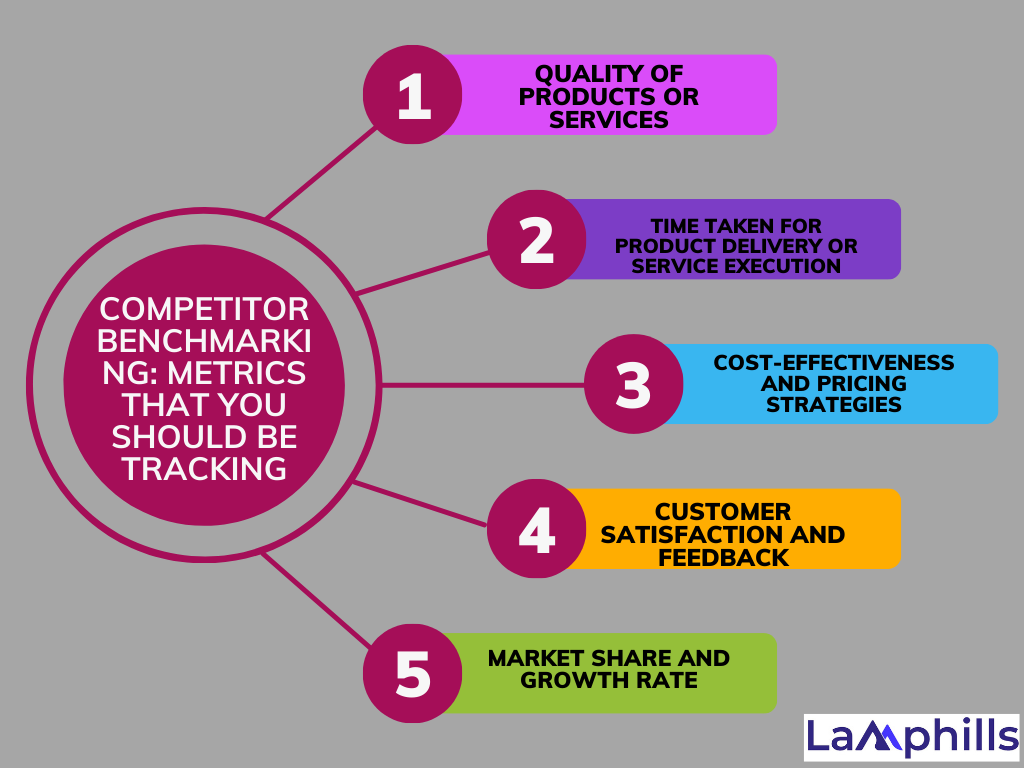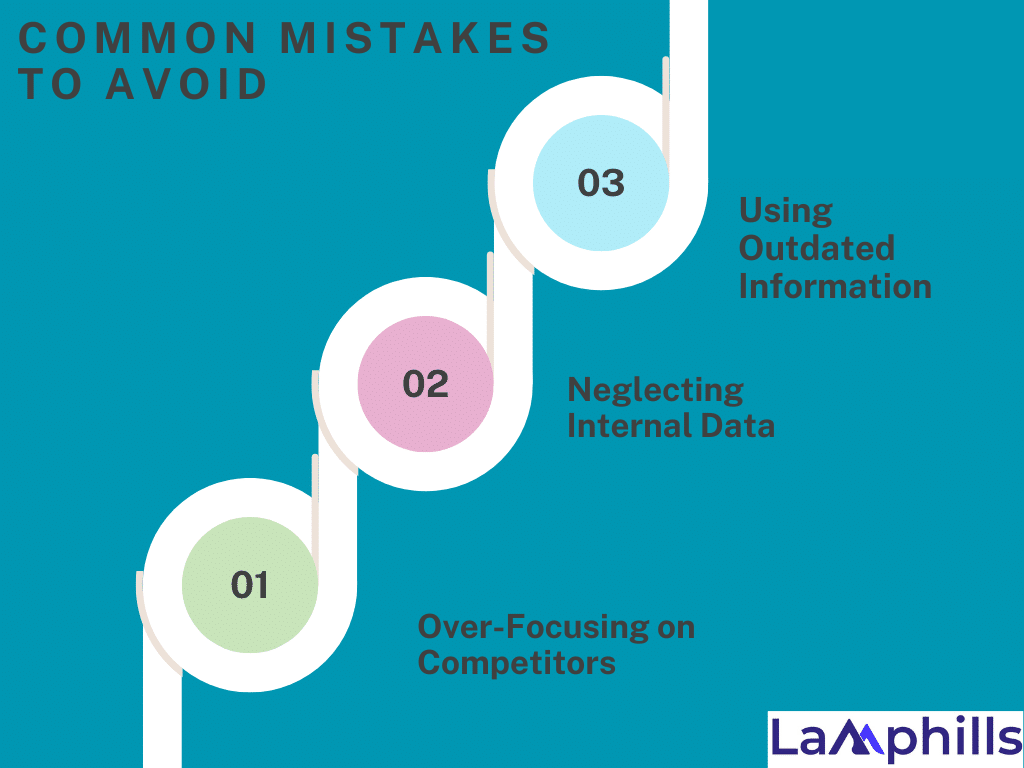Take competitor benchmarking to be your secret weapon in business. It is not only about knowing who your rivals are—learning how you compare to them and using that knowledge to outsmart and outmaneuver them.
It establishes a line of sight across your departments and assists you in developing short- and long-term goals to stay ahead of the curve. Sounds tough? It does not need to be. This guide will teach you all you need to know about competitor benchmarking, from the fundamentals to how to use it to drive major business success.
Key Takeaways
- Maintaining objectivity when comparing your business to competitors helps you see the real picture and identify genuine areas for improvement without bias.
- Focusing on relevant metrics aligned with your business goals ensures that the data you gather is useful and directly impacts your strategic decisions.
- While competitor data is important, internal performance metrics provide valuable insights that can help tailor strategies to leverage your unique strengths and address specific areas for improvement.
- Regularly updating your benchmarking data to reflect current market conditions is essential to staying competitive and making informed decisions based on the latest information.
What Is Competitor Benchmarking?

Competitor benchmarking is the process of monitoring and comparing your brand’s performance to those of your competitors using a set of key performance indicators.
The idea is to learn from your competitors’ strengths while identifying their faults. It assesses their product positioning, marketing and sales techniques, and unique selling points, as well as your position in the industry and whether you are ahead or behind them.
In summary, competitor benchmarking is the process of comparing your company’s processes, performance indicators, and plans to those of its competitors. Imagine it a corporate health check in which you compare your performance in various areas to that of others in your sector. This helps you identify your strengths and areas for improvement.
Why Do You Need to Monitor Your Competitors?
Why bother with all these comparisons? Because knowledge equals power. Benchmarking helps you find gaps in your strategy, evaluate market trends, and discover new potential for innovation. According to the American Productivity & Quality Center, firms that benchmark their processes regularly outperform those that do not by 69%.
Simply stated, the goal is to win! If you haven’t already started this procedure, it should be at the top of your priority list. This is because monitoring the competition can assist you in guaranteeing that your campaigns stand out in a competitive market and/or resonate with your target audience.
One of the most straightforward methods to win is to remain more cost-effective than competitors in the business. So, when allocating your hard-earned marketing expenditures among ad spend, content production, and third-party syndication initiatives, you must be as efficient as possible—and the benchmarking process may help with that.
For example, many digital marketing channels use a bid-based platform, which means that marketers must spend the most amount on a specific term or audience for their ad to appear first (or at all). To optimize your PPC bidding strategy, use competitive intelligence to learn which keywords your competitors are bidding on (or not bidding on).
Competitor Benchmarking: Metrics You Should Be Tracking

The accuracy and application of competitor benchmarking are all about how well you can identify and utilize the relevant KPIs. So, before diving into the process, let’s get familiar with the common competitor benchmarking metrics:
#1. Quality of Products or Services
No matter how colorful or appealing your marketing and sales strategies are, the essential element to developing a successful business is to provide a high-quality product. That is why you need to compare your products and services to those of your competitors. That way, you can determine whether your offerings are strong enough to compete in a crowded market. While this is more of a qualitative metric, some components can be monitored to assess product quality:
- Features, functionalities, and performance
- Reliability and durability
- Innovation rate
#2. Time Taken For Product Delivery or Service Execution
If your competitors can supply the same things faster than you, they will have an advantage in the market. That is why it is critical to assess how your logistics compare to those of your competitors. So, compare your supply chain performance, including supplier lead times, to that of your competitors.
Also, check your lead time against industry norms to discover whether you are falling behind. Your goal should be to outperform or at least match them. While speed is vital, you must also provide great service. So evaluate your service responsiveness, such as your ability to keep consumers updated on delivery status or assist them with tracking information.
#3. Cost-Effectiveness And Pricing Strategies
Your pricing model is another deciding factor behind outperforming your competitors. However, you can only offer competitive pricing when your business operations are cost-effective.
Cost-effectiveness measures whether an outcome of a business operation justifies its costs. Here, you need to compare the cost of production and delivery with the value and quality of the product. Then compare your findings with your top competitors.
#4. Customer Satisfaction And Feedback
In the end, businesses are only successful when their customers are satisfied. That is why customer satisfaction indicators are critical for competitive benchmarking.
To calculate your Net Promoter Score, ask your customers how inclined they are to suggest you to family and friends, and then divide them into promoters and detractors. Use net promoter score software to examine your competitor’s NPS data and compare the two to determine where you stand in terms of customer satisfaction.
Then, monitor third-party review platforms and evaluate the customer comments your competitors are receiving. Compare the number of favorable reviews and average ratings with your competitors. Conduct sentiment analysis, read over the reviews, and determine where you can improve.
#5. Market Share And Growth Rate
Want to examine how successful your competitors are? The market share and growth rate are two useful metrics for your competitor benchmarking framework. Here, you need to find the answer to two key questions:
- Are you gaining or losing market share compared to your competitors?
- How do your growth rates compare?
High market share usually indicates a strong competitive position. However, if your market share is significantly lower than the competitors, you have a lot of room for improvement.
Competitor Benchmarking For Various Channel Types

If you want a holistic view of where you stand against your competitors, benchmarking your performance on various marketing and media channels is also important. Here are some channels you must pay attention to:
#1. Earned Media
Earned media is a great, organic way to increase brand visibility and reputation. Frequent mentions in press releases, news articles, and other third-party content can also help you reach a larger audience.
As a result, you must ensure that your earned media efforts are as effective as or better than those of your competitors. If you find yourself falling back here, assess what gets your competition the spotlight.
McDonald’s gets earned media coverage quite often through well-known news portals and publishers. The brand makes it a point to stay relevant to the pop culture. This further amplifies their exposure via third-party content as well.
Topper Guild’s viral video about McDonald’s secret menu is a notable example of the brand’s earned media.
#2. Social Media
An active social media presence is one of your brand’s most precious assets. To ensure it can outshine your competitors, create specific benchmarks for social media platforms as well. Some important social media metrics you must track and compare here include:
- Followers
- Engagement rate (likes, comments, shares)
- Reach
Taco Bell created a brilliant social media campaign around their limited-time item, the Beefy Crunch Burrito. The fast food restaurant set up a special Twitter handle for this promotion and urged people to show their love for Beefy Crunch Burrito. This resulted in a large stream of user-generated content, with admirers going so far as to get tortilla tattoos and skydiving.
The social media campaign worked well as a customer engagement strategy because it created a sense of urgency and excitement. Taco Bell’s following has practically doubled.
#3. Owned Media
Analyze your competitors’ content assets and check their impressions. See what makes their branded content like website copies and blogs stand out. Here are a few things to focus on while evaluating your competitor’s owned media exposure:
- Image count
- Video count
- Title and description length
- Keyword usage
- Readability
For example, software company ASG uses extensive owned marketing through its blog page to promote its new initiatives, partnerships, and acquisitions.
#4. Paid Media
Monitoring your competitors’ marketing activities and campaigns is often a useful benchmarking activity. Consider the types of commercials they run, the technologies they utilize, and the funding they set aside for marketing initiatives. Then look at the campaign results and compare them to your own.
For example, the co-founder of the SaaS startup Hipchat wanted to conduct billboard campaigns but felt he couldn’t compete with his competitor’s marketing spend. So, rather than renting a billboard, he purchased vacant locations at a far reduced price. This allowed him to fit his paid marketing plan within their limited budget. As a result, the venture experienced a 300% increase in web searches.
How to Perform a Benchmarking Analysis On Competitors

Till now, we have attempted to understand the process. Now, it’s time to dive into how to do competitor benchmarking: let’s look at some simple steps you can take to start doing competitive benchmarking:
#1. Define Clear Goals and Objectives
Knowing why you’re benchmarking matters just as much as the process itself. Start by writing down your objectives, which will help to guide the process.
#2. Make a List of Your Competitors
First and foremost, you should understand who your competitors are. These can be direct competitors who provide identical products or services, or indirect competitors that address the same customer needs in different ways. Create a comprehensive list using tools such as Google Search, social media, and industry publications.
To assess your rivals, you must first identify who they are. Direct competitors are those who have a similar product and compete directly for your audience, whereas indirect competitors are those who share your audience but do not necessarily have a comparable product.
If you don’t know who your main competitors are, run a quick Google search for what you sell to see who comes up. From there, you can do some digging to see who their audience is, their company size, and other details and take it from there.
#3. Establish Benchmarking Metrics
Benchmarking metrics help you focus on the right data to measure. This might be sales, content marketing engagement, media mentions, share of voice, website traffic, SEO, customer satisfaction scores, customer churn, or any number of things that indicate your competitors’ success. Tie your metrics back to your objectives. There are lots of things you can measure, but which metrics will help you achieve your initial objectives?
#4. Gather Data on Competitors
Collect competitor data from reliable sources. Make sure they are current and relevant. You can examine financial reports, customer feedback, and survey results to collect data. Many top brands even release their business strategies and marketing methods for public records.
Collecting data is a mix of art and science. Here’s how you can do it:
- Online Research: Use the tools mentioned earlier to gather data on competitors’ online activities.
- Surveys and Feedback: Direct customer feedback can provide valuable insights.
- Mystery Shopping: Act as a customer to understand the competitor’s service experience.
You can also use tools like Keyhole to identify trends and assess the audience’s interest in your competitors. For example, if you are a chocolate brand, you can check out the audience’s interest over time, mentions, potential impressions, sentiment, etc in a graph format using Keyhole’s QuickTrends feature.
#5. Analyze and Compare The Data
The next step after gathering data is to analyze it. To understand client attitudes, use qualitative analysis, while quantitative analysis is used to calculate measurable indicators. For example, if your competitor’s product characteristics are frequently lauded in reviews, evaluate how you may benefit from their strategy.
Now, assess your brand’s performance and compare it to that of your competitors. To eliminate the human labor, you can use an AI-automated competitor analysis tool.
For example, we’ve compared the Instagram presence of chocolate firms Fererro and Hershey. You can view a summary of various profile metrics for both brands. Keyhole’s rival benchmarking function also identifies the top posts of your competitors and lets you see where they are doing better or worse.
#6. Report Findings And Implement Changes
Document the findings in specific silos and share the reports with stakeholders and leadership. Take proactive actions based on the generated insights.
A benchmarking report should be clear and actionable. Include:
- Executive Summary: Key findings at a glance.
- Data Analysis: Detailed analysis with charts and graphs.
- Insights: What the data means for your business.
- Recommendations: actionable steps based on insights.
Ensure that competitor benchmarking becomes a regular addition to your business calendar and repeat the process.
Best Practices and Pitfalls to Avoid
Also, make references to the checklist below,
When diving into competitor benchmarking, it’s easy to get overwhelmed with data and comparisons. Here’s how to stay on track and ensure your efforts are both effective and efficient.
#1. Maintain Objectivity
Assume you are comparing your business to your neighbor’s garden. If you become overly devoted to your tulips, you may overlook the reality that their roses are the center of attention. Similarly, in business, it is critical to be objective. Analyze the data without bias. Regularly evaluate your benchmarking measures and compare them objectively. This enables for honest appraisals and aids in identifying genuine areas for growth.
#2. Ensure Consistency
Consistency is key in benchmarking. Think of it like a fitness routine. If you only exercise sporadically, you won’t see the results you’re aiming for. The same goes for benchmarking – it needs to be a regular part of your business strategy.
To do this, set a regular schedule for benchmarking activities. Whether monthly, quarterly, or biannually, consistency helps track progress and make timely adjustments.
#3. Focus on Relevance
Relevance ensures that the data you gather and analyze is useful. It’s like cooking – if you’re making a cake, knowing the price of flour is more relevant than the price of tomatoes.
Tip: Choose metrics that align with your business goals. If your goal is to increase sales, focus on metrics related to customer acquisition and conversion rates rather than just general traffic numbers.
Common Mistakes to Avoid During Competitor Benchmarking

Make sure to avoid the mistakes below
#1. Over-Focusing on Competitors
It’s easy to become obsessed with what others are doing, but remember the story of the tortoise and the hare. Constantly watching your competitors can make you lose sight of your strengths and strategies.
While it’s important to be aware of competitor activities, balance it with a strong focus on your unique value propositions and strengths.
#2. Neglecting Internal Data
Your internal data is a treasure trove of insights. Ignoring it in favor of competitor data is like ignoring your own garden’s soil quality while admiring your neighbor’s flowers.
Use internal performance metrics to complement your benchmarking efforts. This provides a holistic view and helps in making more informed decisions.
#3. Using Outdated Information
In today’s fast-paced corporate environment, yesterday’s data might quickly become obsolete. Relying on out-of-date information is similar to using an old map on a road trip; you may get lost. Regularly update your benchmarking data to reflect current market realities. This guarantees that your strategies are based on current facts.
By adhering to these recommended practices and avoiding common mistakes, you may maximize the benefits of competitor benchmarking. Remember, it’s not just about keeping up with the Joneses; it’s about applying what you’ve learned to grow and improve your own business.
Benefits of Benchmarking Your Competitors

From reducing costs to improving product positioning, competitive benchmarking can be a very rewarding process. Here’s why you must prioritize it:
#1. Get an Objective View of Your Organization
Most marketers understand their brand’s position in the marketplace. Marketers, on the other hand, can be overly familiar with the scenario. It is preferable to support your understanding of your market position with facts. That is exactly what benchmarking attempts to accomplish. Get an independent assessment of how you stand up in the market, regardless of how fantastic you believe your product or service is.
#2: Increase Sales and Revenue
As you identify fresh areas for improvement, your sales and revenue should increase. That is the whole goal of making changes, right? You want to produce a product that outperforms your competitors’ offerings. By doing so, you will be able to collect more of the market as well as retain existing customers so they don’t go to a competitor. Improvements are likely to lead to more sales, greater customer satisfaction, increased referrals, and even more media coverage.
#3. Keep Track of Competitors
You might have an edge over your competitors for now. But what happens if they start gaining on you? What about when new competitors enter the arena? Or a competitor shift course completely?
While you might not follow suit, it is a good idea to keep tabs on what your competitors are doing. If they’re growing faster than you, getting more media opportunities, have stellar content marketing performance, or are otherwise besting you in certain areas, that’s a sign you might need to up your game.
#4. Stay on Top of New and Emerging Trends
Benchmarking data can help you identify methods to improve your brand’s market position. This has been more critical than ever in recent years, considering how swiftly market conditions can shift. With constant benchmarking, brands may keep on top of developments that may upset their present position, giving them more time to respond.
For example, consider the global epidemic. Marketers threw their strategy out the window as lockdowns occurred and supply chains were turned upside down. They have to immediately modify their messaging, content, and offerings to meet the new normal. This is an extreme scenario, of course, but it does highlight the reality that marketers must be prepared. for the unexpected. The sooner you can see new challenges coming, the more quickly and fluidly you can adapt (ideally before your competitors do!).
#5. React More Quickly to Market Shifts
Aside from trends, market upheavals occur, which might open up new prospects for brand growth. Fads and fads come and go, customer preferences shift, and new products gain popularity in various marketplaces all the time. These developments can let you engage with previously unknown audiences.
#6. Improve The Overall Company Culture
Competitive benchmarking not only helps firms identify areas for improvement, but it also motivates them to take action. It demonstrates your commitment to taking the firm ahead, which can assist create trust in your personnel. Helping to future-proof your firm boosts employee satisfaction and well-being, productivity, and a desire to constantly grow.
#7. Identify Opportunities For Improvement
As the old saying goes, when two enterprises are identical, one is unnecessary. Every organization has advantages and disadvantages. Learning about your competitors’ vulnerabilities can help you uncover gaps in their approach that you can fill with your own products and services. Knowing their strengths can motivate you to improve your offering.
Naturally, you will want to learn about the same topics in your organization. Improving your flaws and using your strengths can help your firm continue to thrive and maintain a competitive advantage.
#8. Spur New Ideas and Innovation
As you uncover new strengths, weaknesses, threats, and opportunities, new ideas and innovation become natural byproducts. Staying in tune with competitors can help you come up with ideas to improve and innovate, often in ways you couldn’t even imagine. Stay positioned for success at all times, even if you don’t always know what success will look like. It can at least point you in the right direction when you notice your competitors are doing something differently.
#. 9 Avoid Becoming Obsolete
Failure to innovate can have disastrous consequences for a corporation. It could imply allowing your competitors to take the lead in the market. Worse, you might get edged out entirely. Take Polaroid, for example. The company was previously considered the gold standard for instant film photography.
However, digital technology gradually overtook Polaroid products, rendering them almost obsolete. Consumers’ interest in antique technology and film in recent years has resulted in a recovery for Polaroid, but not before the brand suffered significant damage due to a failure to innovate.
Other brands haven’t been as lucky. Kodak, Nokia, and Blockbuster have all nearly become extinct due to a failure to adapt to changing circumstances.
What Are the Activities Under Competitors’ Benchmarking?
It involves identifying similar businesses in the industry, analyzing their strengths and weaknesses, and evaluating their market share.
What Are the 4 Areas for Benchmarking?
There are four main types of benchmarking: internal, external, performance, and practice.
What Are Competitor Activities?
Competitive Activities means any activities (including preparations) that compete with, are intended to compete with, or otherwise may adversely affect or interfere with the Corporation Group’s business or advantage a Competitor whether immediately or in the future.
What Is an Example of Competitive Benchmarking?
One example of competitive benchmarking is the rivalry between two major smartphone manufacturers, Apple and Samsung..
Wrapping up
Competition is inevitable. Hence, how you learn from it can make or break your business. But, if done right, competitor benchmarking can help you stand out through strategic improvements and innovations. You can gain and sustain a competitive advantage by understanding your competitors’ market positions, strengths, and limitations.
So why delay? Begin your benchmarking adventure today. Look around, collect data, and take decisive action to outperform your competitors. Remember that staying ahead in today’s fast-paced corporate environment necessitates not only hard work but also smart work.






